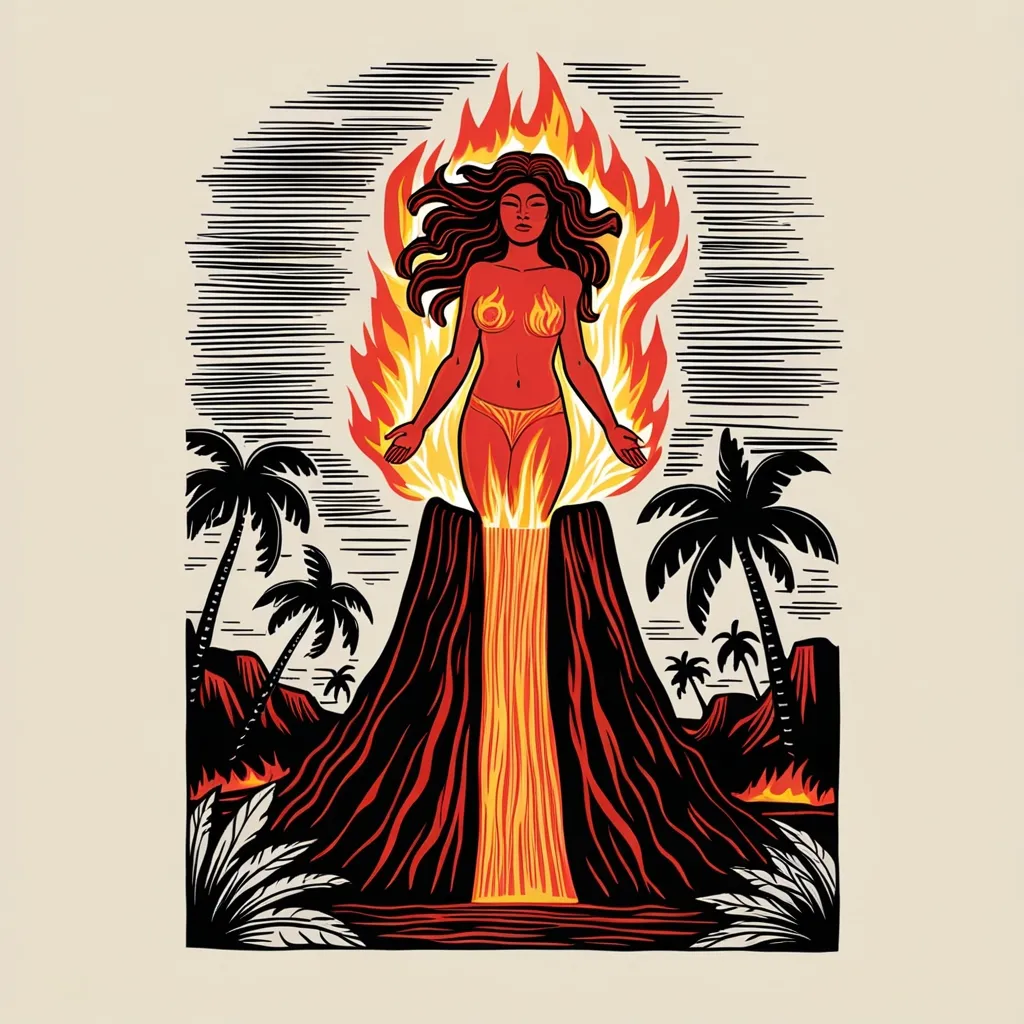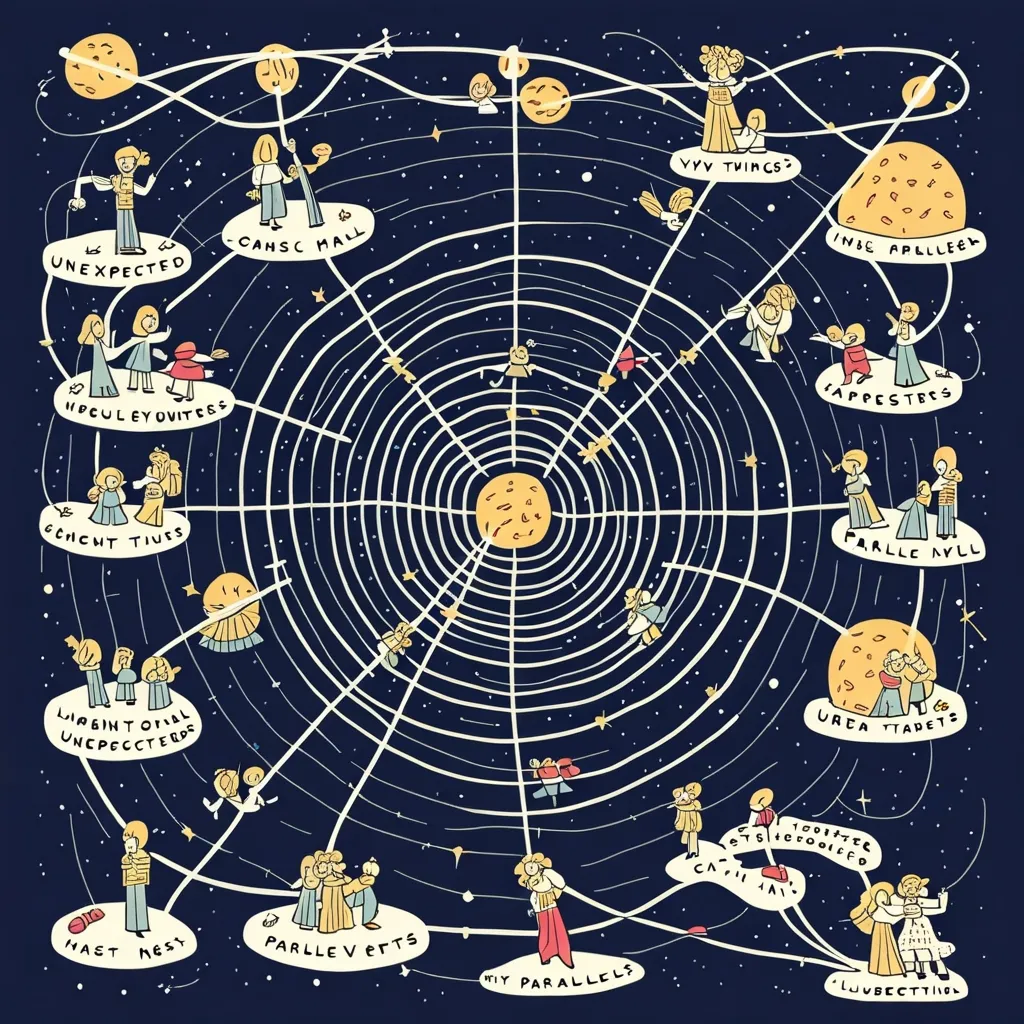The Legend of Pele: Hawaii’s Fiery Goddess
Deep in the heart of Hawaii, a powerful force shapes the very land beneath our feet. Her name is Pele, the goddess of volcanoes and fire. She’s not just some ancient myth - Pele’s presence is felt in every rumbling eruption, every flowing river of lava, and every whisper of wind across the islands.
Locals often call her “Madame Pele” or “Tūtū Pele” out of respect. After all, she’s the one who created the Hawaiian Islands, building them up from the sea with her fiery touch. Most folks believe she lives in Halemaʻumaʻu crater at the top of Kīlauea, one of the world’s most active volcanoes.
Pele’s story is a wild ride from the start. She was born way back in Kahiki (probably Tahiti) to some pretty important parents - Haumea the Earth goddess and Kane Milohai, who created, well, everything. But Pele wasn’t exactly a model daughter. She had a nasty temper and got mixed up in a scandalous affair with her sister’s husband. Talk about family drama!
That little indiscretion got Pele kicked out of her homeland. So she hopped in a canoe and set sail for Hawaii, searching for a place to call home. But her sister Namakaokahai, the sea goddess, wasn’t about to let her off easy. She chased Pele across the ocean, determined to teach her a lesson. This started an epic sibling rivalry that still plays out today in the constant battle between fire and water on the islands.
Now, Pele’s got a bit of a reputation for her temper. She’s known to show up in different forms - sometimes as a stunning young woman, other times as a wrinkled old granny. She might even bring along a white dog. But don’t let her looks fool you. Pele’s quick to anger, and she doesn’t take kindly to disrespect.
There’s this famous story about a young chief named Kahawali who ticked Pele off during a sledding race. Big mistake. Pele chased that poor guy with a river of lava, forcing him to flee all the way to Maui to save his skin. It’s a good reminder to always show respect to Pele and the forces of nature she controls.
Speaking of sledding, Pele’s got another legendary tale involving a race. This time, she went up against Poliʻahu, the goddess of snow and ice who lives on Mauna Kea (Hawaii’s tallest mountain). Pele, feeling a bit jealous of Mauna Kea’s height, challenged Poliʻahu to a sledding contest down the slopes.
Well, things didn’t go Pele’s way. She kept losing, and you know how she feels about that. In a fit of rage, she attacked Poliʻahu with her fire. But Poliʻahu’s snow proved to be a tough match for Pele’s flames, and our hot-headed goddess had to retreat back to her volcano.
This battle isn’t just a cool story - it’s got some deeper meaning. It’s all about the balance between fire and ice, and how even the most powerful forces need to respect each other. It also shows that Pele, for all her strength, isn’t invincible. Sometimes, she meets her match.
Despite her fierce side, Hawaiians have a deep respect for Pele. During volcanic eruptions, you’ll often see people leaving offerings for her along the roads - things like flowers, fruits, and other gifts. It’s their way of showing respect and asking for her mercy.
This tradition of honoring Pele gets passed down through generations. Many Hawaiians still chant and make offerings during times of volcanic activity. It’s not just about trying to appease an angry goddess - it’s about recognizing the powerful natural and spiritual forces that shape their world.
Ever heard of the “curse of Pele”? It’s this popular belief that warns against taking rocks or sand away from Hawaii. Legend has it that anyone who removes these natural elements from the islands will face Pele’s curse, bringing bad luck and misfortune into their lives. While it might sound like a spooky campfire story, it really shows how deeply Hawaiians are connected to their land and to Pele herself.
Now, let’s talk more about that sister rivalry I mentioned earlier. Pele and Namakaokahai couldn’t be more different. While Pele’s all fire and fury, Namakaokahai is the cool, calm goddess of the sea. But don’t let that fool you - when these sisters clash, it’s epic.
When Pele finally settled on the high peaks of Mauna Loa, she thought she’d found a safe spot away from her sister’s waves. But that didn’t stop the battles. Pele’s eruptions would send lava flowing thick and hot until it hit the sea, where Namakaokahai’s domain began. This constant back-and-forth between the sisters represents the eternal struggle between fire and water, and how each element must respect the other’s power.
Pele isn’t just some ancient myth gathering dust in history books. She’s still very much a part of Hawaiian life today. Take the 2022 eruption of Mauna Loa, for example. Thousands of people came to see the world’s largest active volcano do its thing. But it wasn’t just tourists with cameras. Many Hawaiians made the journey to pay their respects to Pele, leaving offerings and chanting in her honor.
This event really showed how Pele is still a living, breathing part of Hawaiian culture. She’s not just a character in old stories - she’s a spiritual force that people connect with today. Her eruptions are seen as both destructive and creative, wiping out old land while forming new islands.
Lots of folks claim to have had personal encounters with Pele. You’ll hear stories about people picking up an old woman in white on the side of the road, only to look in the rearview mirror and find the backseat empty. Others swear they’ve seen Pele’s face in the smoke rising from an erupting volcano or in the swirls of a lava flow.
Whether these encounters are real or just products of imagination, they show how much respect and awe people have for Pele. She’s a goddess who demands attention, and those who honor her are often said to be protected from the worst of her wrath.
Pele’s influence goes beyond just volcanic activity. She’s become a symbol of Hawaiian identity and resilience. In a world where ancient traditions often get lost, Pele remains a powerful link to the past. She reminds Hawaiians of their connection to the land and the importance of respecting nature’s power.
Artists frequently depict Pele in their work, capturing her fierce beauty and the raw power she represents. You’ll find her image in paintings, sculptures, and even modern street art across the islands. These artistic representations help keep Pele’s legend alive for new generations.
Pele’s story also serves as a cautionary tale about the dangers of human hubris. In a time when we often think we can control or tame nature, Pele reminds us of the awesome and sometimes destructive power of the natural world. Her eruptions have destroyed homes and reshaped landscapes, showing that no matter how advanced our technology becomes, we’re still at the mercy of greater forces.
Interestingly, Pele’s influence extends beyond Hawaii. As people from around the world learn about her legend, some have adopted aspects of her story into their own spiritual practices. While this sometimes leads to debates about cultural appropriation, it also shows the universal appeal of Pele’s powerful symbolism.
For geologists and volcanologists, Pele represents the fascinating intersection of science and culture. While they study the technical aspects of volcanic activity, many also respect the cultural significance of Pele to the Hawaiian people. This blend of scientific knowledge and cultural understanding leads to a richer, more holistic approach to studying Hawaii’s volcanoes.
Environmental conservationists often invoke Pele’s name when advocating for the protection of Hawaii’s natural spaces. They argue that respecting Pele means respecting the land itself, promoting responsible tourism and sustainable practices that preserve Hawaii’s unique ecosystem for future generations.
In Hawaiian schools, the legend of Pele is often used to teach important cultural values. Through her stories, children learn about respect for nature, the importance of family (even when relationships are complicated), and the consequences of unchecked anger. Pele’s tales provide valuable life lessons wrapped up in exciting, memorable narratives.
As climate change affects weather patterns and sea levels worldwide, some Hawaiians see Pele’s increased activity as a response to these global shifts. Whether this is scientific fact or cultural interpretation, it underscores how Pele remains relevant in addressing modern environmental concerns.
At her core, Pele embodies the dual nature of fire - its capacity for both destruction and creation. Her eruptions may destroy forests and homes, but they also create new land, expanding the islands and providing rich volcanic soil for agriculture. This duality reminds us that even in loss, there can be renewal and growth.
Pele’s enduring legend speaks to something deep in the human spirit. She represents the wildness of nature, the power of passion, and the importance of respect. In a world that often feels disconnected from the natural forces that shape it, Pele stands as a fiery reminder of our place in the greater scheme of things.
So next time you hear about volcanic activity in Hawaii, remember - it’s not just geology at work. It’s Pele, the goddess of fire and volcanoes, shaping the land as she has for centuries. Her story is one of power, passion, and the enduring spirit of the Hawaiian islands. And as long as the volcanoes of Hawaii continue to rumble and flow, Pele’s legend will live on, a blazing testament to the raw beauty and power of nature.






